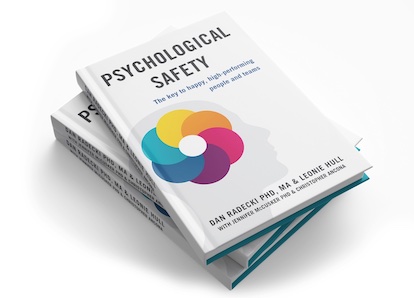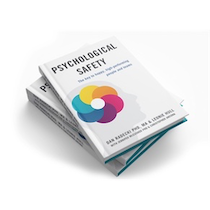The Golden Rule is wrong!
(managers who use it destroy their team)
There is an old saying “Treat people how you want to be treated”, but with what we know through Neuroscience research, this advice needs an upgrade.
Today, what we know is that brains have different sensitivities to triggers. Specifically, there are 6 big ones that fit into the acronym S.A.F.E.T.Y.™:
- Security: The need for certainty, consistency, and no change.
- Autonomy: The need to feel in control of one’s decisions
- Fairness: The need for just treatment
- Esteem: The need for feeling an elevated position in the social hierarchy
- Trust: The need to be part of a group that is “like us”
- You: Your own triggers that come from your background, culture, and upbringing
Whilst we essentially all have these brain ‘needs’, we vary in our sensitivity to them.
Let’s consider a person on my team with a high sensitivity to Security and a low sensitivity to Autonomy and contrast that with my low sensitivity to Security and high sensitivity to Autonomy. If I treat my team mate according to the ‘Golden Rule’ (ie as I want to be treated), I would give them the big picture with basic directions and allow them to set their own time and performance targets. The issue is that this lack of detail, direction and structure would cause my team-mate confusion and frustration and would likely result in them either performing poorly, leaving, or both.
Now what if I had a deep need for Trust, and a team member had a low need. I may want to have a lot of after work social events to make sure the team had strong identity and cohesiveness, while my team member may just want to focus on doing their job and find the social activities after work hours annoying, preferring to just go home to spend time with family. When I assume everyone has a high need for Trust like me, then someone not participating would come across as a poor team player. This is very likely to cause tension and disconnection in the relationship.
Or if I had a low need for Esteem, I may set up a very blunt and open feedback process for my team – where everyone got feedback openly and publicly. I would not want feedback to be hidden and would feel this process was honest and transparent – just the way I like things to be. However, a person who is high in the need for Esteem may be very threatened by this process – finding it embarrassing and even degrading.
From the examples above, you can see why Google’s research found Psychological Safety to be the number one determining factor of a high-performing team. Because, when you don’t have safety it constantly causes emotional responses that suck up valuable brain space – sapping focus, reducing efficiency, and killing the creative and innovative energy in a team.
In all of these cases, I would have been treating my team members ‘just as I would like to be treated’ – I would have been following the ‘Golden Rule’. However, if I were aware of their brain’s needs, then I would act the exact opposite. As their manager, I would treat them like they want to be treated, NOT how I want to be treated. In the first case, I would give the person with high need for Security more direction. In the second case, I would value the person’s skills and contribution to the team and respect how they choose to spend their free time, and in the third case, I would change my feedback process to ensure I did not threaten peoples Esteem – maybe by giving positive feedback in public and constructive feedback in private.
From our experience, when managers use the Golden Rule as their guiding principle they can be making major mistakes that lead to a couple of significant problems.
Firstly, a lack of diversity. I do not mean diversity of skin color, gender, or sexual orientation – those are superficial characteristics. When it comes to work capabilities, efficiency, and the ability to innovate, the needed diversity lies deeper – diversity of the brain. This is the diversity that matters to the bottom line, to efficiency, creativity and performance – the invisible diversity of thought.
And secondly, it leads to terrible inefficiencies as those who think differently are demoralized, confused, and simply unable to perform at their best. This will continue until they leave, or are fired and replaced – leading to another significant problem.
Managers who treat their team according to their own brain needs tend to lose employees with different brain needs as they tend to get pushed out in one way or another. This leaves the manager to search for people who appreciate their style, which leads them to build a team of people just like themselves. This results in a lack of S.A.F.E.T.Y.™ diversity, and gaps in the strengths that various profiles bring to the team – leading to underperformance over time.
When we train leaders in the Brain-based approach to Psychological Safety, introducing them to the S.A.F.E.T.Y.™ framework and their team’s profile and pulse, leaders have surprising insights and AHA moments. It often comes as a shock when they discover that, whilst they believed they were doing a great job leading their people (the way they want to be lead), team members are ranking their psychological safety on the team as very low.
This is no fault of the leader, as without the framework and language of S.A.F.E.T.Y.™ these nonconcsious drivers are invisible, hard to pin-point and difficult to articulate. Once the team has this shared awareness and language and are equipped with the tools to support them, they are better able to understand, communicate and manage their own, and one another’s psychological safety needs.
As we unpack their team S.A.F.E.T.Y.™ profile they begin to realize why they have been missing the mark and failing to meet the needs of their team members. With this knowledge, and the tools to support them, they can then take the necessary steps to effectively build team strength, efficiency, connection and innovation.
If you want to find out more about the Brain-based approach to Psychological Safety, you can start with our book, available on Amazon.













